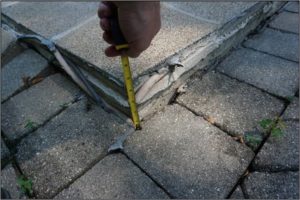With summer on the way and temperatures rising, many people will be looking to spend some time poolside. Pools can be fun and relaxing, and offer a respite from the heat. However, in addition to the ongoing maintenance and care that pools require, failures of pool components and systems can be problematic and cause headaches for the pool owner. Some common failure types include pool equipment failures, plumbing failures, material failures (commonly failures of pool plaster or decorative tile), and failures related to movement. These failures can be caused by natural perils, inadequate maintenance, improper design and/or construction, or a combination of those factors.
While remarkable failures of above-ground pools can result in entertaining content, this discussion will focus on failures related to movement of the pool structure/shell elements of in-ground pools. Structural movement of a pool shell is commonly caused by one of the following: buoyancy (the force of water outside the pool acting on the pool shell), expansive soils, or settlement.
Of these, buoyancy often creates the most sudden and significant failures. Water in the soils surrounding the pool will exert upward pressure on pool shells and other below-grade structures that reside within the influence of the water table. When the pool is full, this buoyant force is resisted by the weight of the pool water and the weight of the pool shell itself.
If water is removed from the pool (such as when the pool is drained for cleaning/maintenance), the effects of buoyancy must be considered. This is commonly done with hydrostatic pressure relief valves installed on the bottom of the pool that either open automatically or are physically opened when the pool is drained to allow water to pass from the water table into the pool, relieving the buoyant pressure. If such relief valves do not exist, are not opened, or do not perform properly, the buoyant forces can cause significant movement to a pool (Figure 1). This movement often causes significant damage to the surrounding pool deck and paving elements (Figure 2).

Figure 1. Significant upward movement of a pool shell due to buoyant forces on a partially-drained pool.

Figure 2. Damage to pavers around a pool that has experienced upward displacement
A significant pool leak can have a similar effect. Figure 3 shows a fiberglass in-ground residential pool that experienced a sudden leak due to a shell puncture, resulting in warping and further fracturing of the shell from the upward forces.

Figure 3. Warped and fractured fiberglass pool shell due to buoyant forces from a sudden leak, which drained much of the pool water
The presence of expansive soils can influence movement of a pool structure and of the surrounding pool deck. Such soils expand when their moisture content increases, such as from changes to a site and the addition of nearby irrigation. This movement can create significant distress around the pool over time and, if severe enough, can cause plumbing leaks and further issues.
Pool movement due to settlement is typically less severe than that related to buoyant forces or expansive soil movement, although differential settlement can cause separations and damage at joints between the pool shell and surrounding elements.
Nelson’s team of professionals is experienced in the evaluation of different types of failures that can affect swimming pools and their surroundings, and can provide appropriate recommendations for repair.

